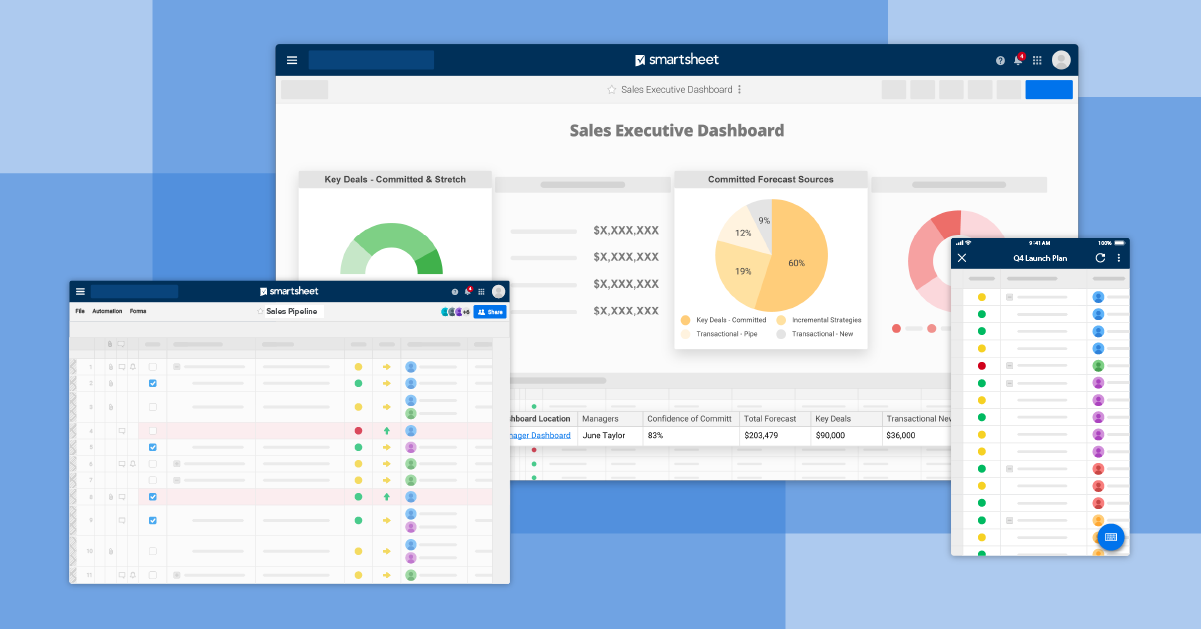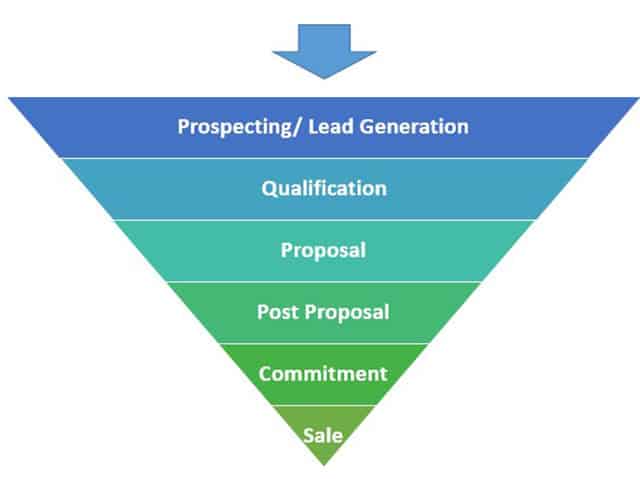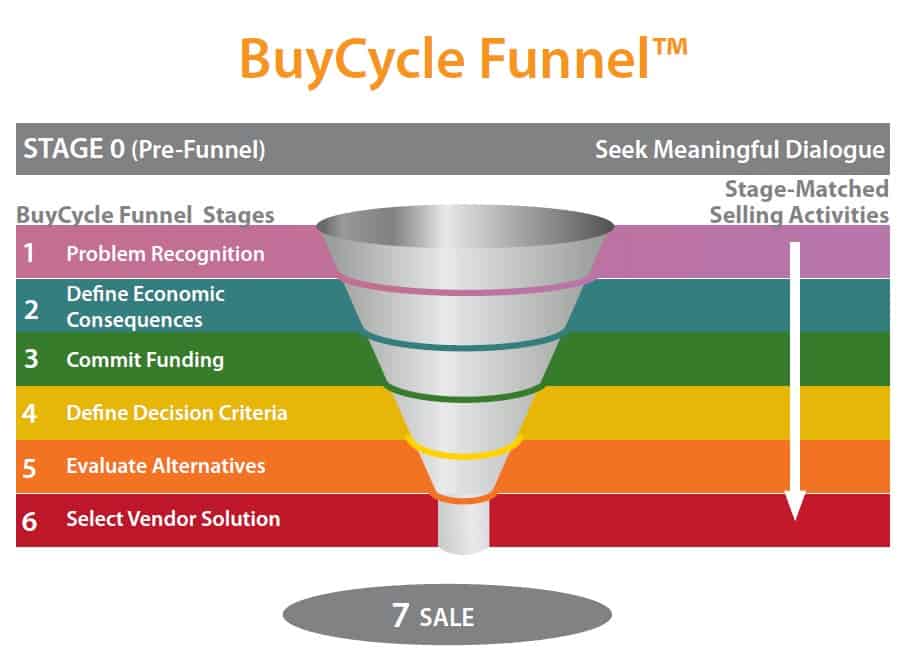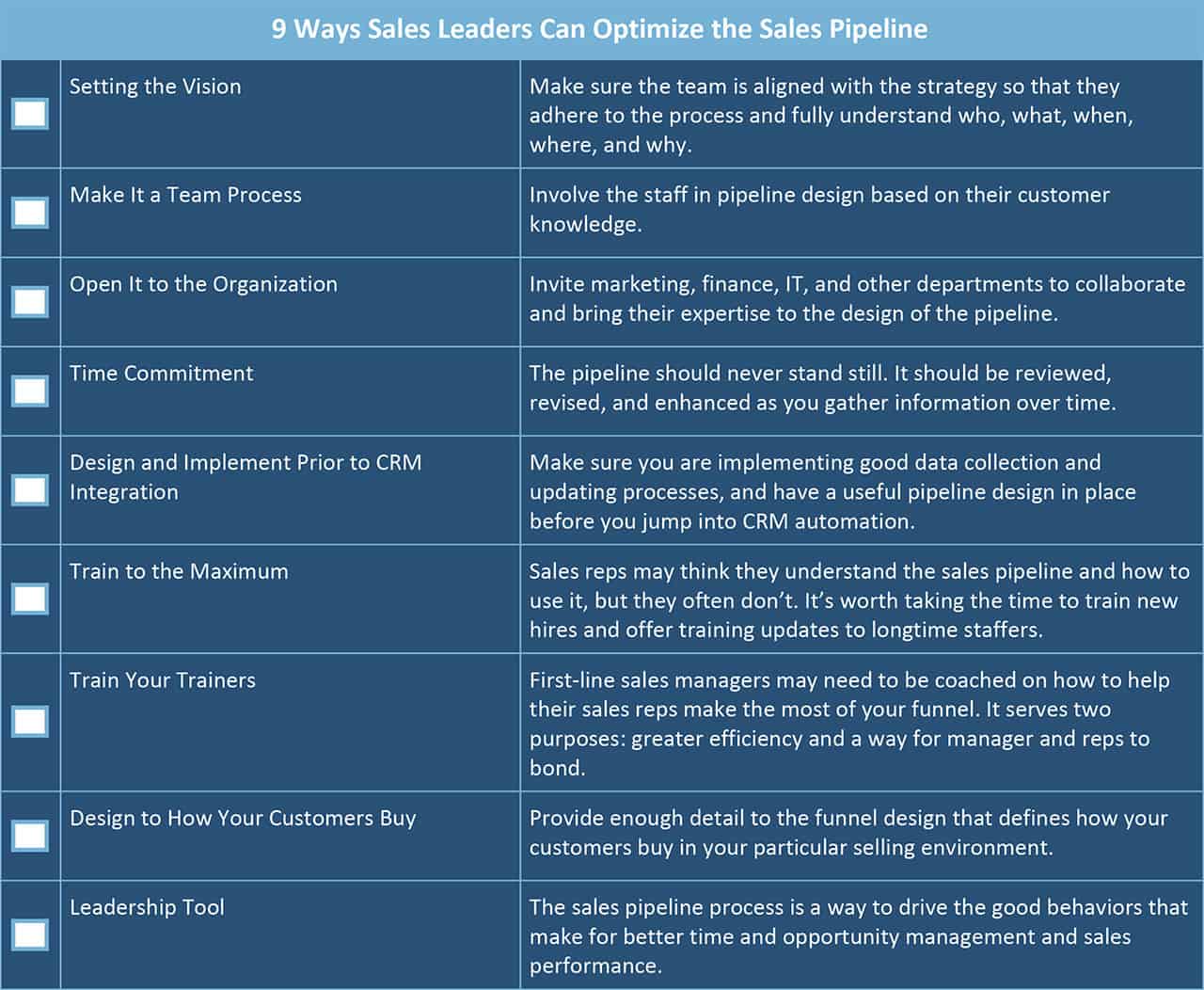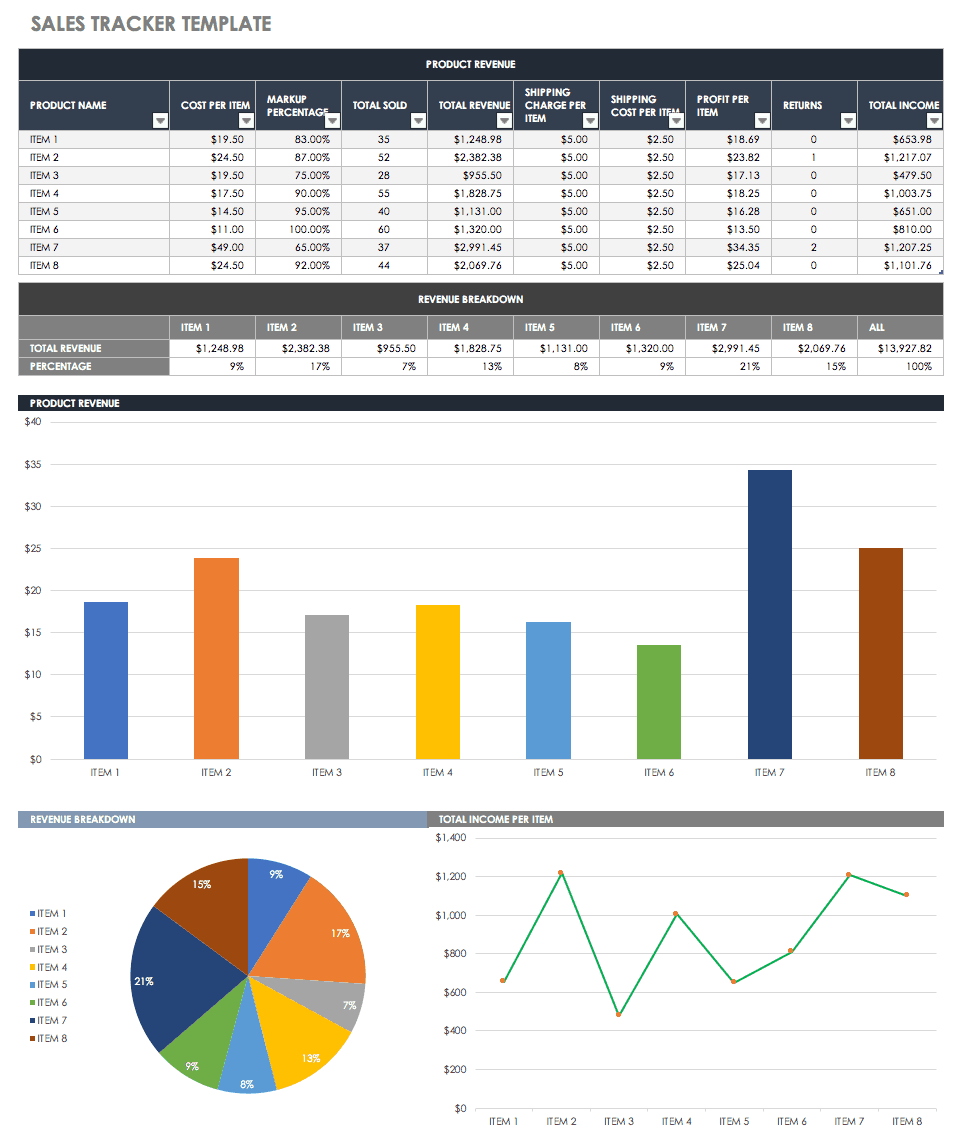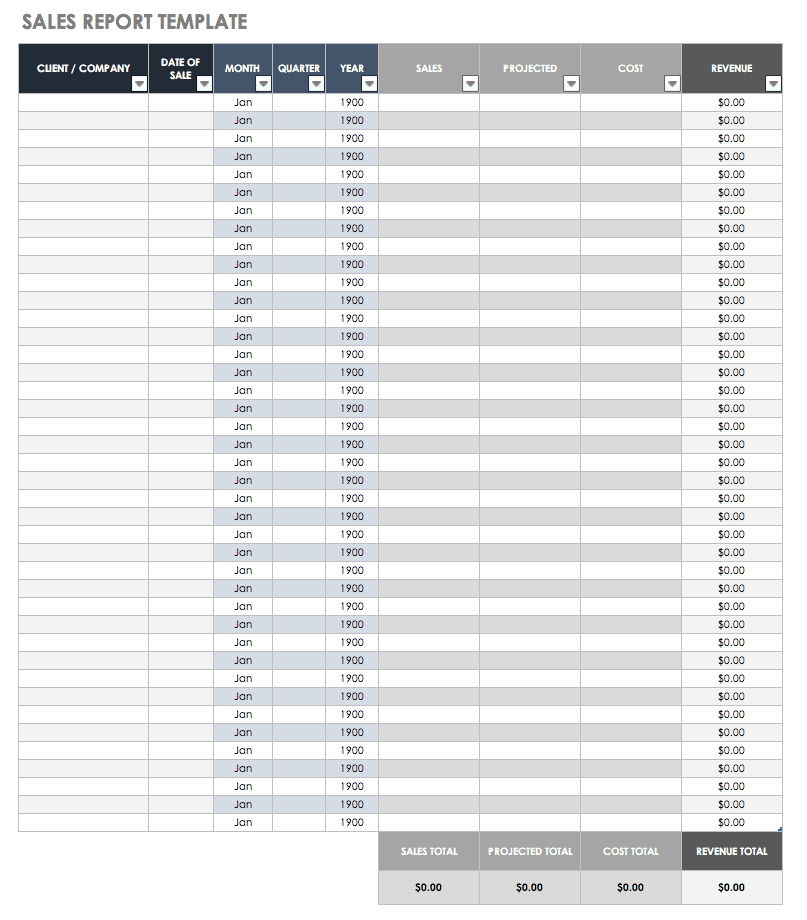What Is a Sales Pipeline?
A sales pipeline is a visual representation of the sales process divided into stages. An effective sales pipeline will help sales reps and teams manage the often complex processes necessary to close deals. We asked a B2B sales pipeline expert to share what he’s learned over the last two decades about how to design your sales pipeline and keep it ‘clog free.’
Keep deals moving forward with sales pipeline management in Smartsheet
Smartsheet is a cloud-based platform that allows sales teams to effectively manage pipelines by creating one location to track and manage efforts, surface open and at-risk opportunities, and provide real-time visibility to improve forecasting. See Smartsheet in action.
What Is Sales Pipeline Management?
According to Sellers, a good definition of sales pipeline management is: “The tracking and management of every sales opportunity through every stage to a successful close of a revenue producing contract.” He adds, “It’s about the task in total: finding, qualifying, and winning not just one sale, but doing the right things throughout the year to help salespeople do what they are expected to do - achieve their sales quota.”
Why a Sales Pipeline Is Important
The bottom line on sales pipelines actually is the bottom line: effective management of them increases revenue. According to the Harvard Business Review, “Companies with effective pipeline management had an average growth rate of 5.3, a 15 percent increase. Even more interestingly, companies that mastered three specific pipeline practices saw 28 percent higher revenue growth.” Those three practices are:
- Having a clearly defined sales process
- Spending time on the process
- Training sales managers in pipeline strategies and techniques.
Having a sales pipeline is important for other reasons, too:
- More Accurate Forecasting: Pipelines provide a look into each sales rep’s activity, how close they are to making quota, and in the aggregate, how near or far the whole team is from meeting the target quota. Using that information generated by the sales team, it’s easier to provide 30, 60, and 90 day (or beyond) revenue forecasting. Knowing what and when you’ll be closing sales is critical to other company departments like finance, operations, and manufacturing.
- Targeted Resource Allocation: By understanding where you are at each pipeline stage for each customer or opportunity, you can take steps to allocate resources to help close business. Sales managers can determine which deals are critical, and whether or not they’ll need more time and oversight.
- More Effective Sales Team Management: Behind each stage there are actions to complete in order to successfully finish that stage and keep the opportunity moving through the pipeline. Tracking key metrics frequently means that sales managers can identify and ease challenges for each rep before they impede sales.
- Increased Deal Velocity: If it’s taking too long to move opportunities from stage to stage, tracking data will make that apparent. For example, let’s say your annual sales goals per sales person is $5,000,000. If 50 percent of your sales team has reached $1,000,000 in sales six months into the sales year, it means you should take a look at individual performance, and take steps to make improvements based on the data you’ve gathered.
- Increase Total Deal Volume, Size, and Revenue: You want the number of opportunities to grow, and for the size of those opportunities and the dollar amount they generate to keep growing, too. A sales pipeline illuminates when to spend less energy on specific types of opportunities, what to remove from the process, and which situations to pursue more vigorously.
A well-managed sales pipeline is about continuously improving the process itself, and honing the skills of your salespeople. Everyone’s aim should be to keep the pipeline moving as quickly as possible from one stage to the next - and of course, to close sales.
Sales Pipeline Stages
Identifying sales stages is nothing new. In 1887, John H. Patterson drove sales by training his National Cash Register (NCR) sales team. He used his Primer that divided every sale into four stages: approach, proposition, demonstration, and close.
The number of stages in a pipeline has increased since the 1960s into some variation of these five stages, based on the company’s selling process:
Sellers notes that today, a sales pipeline flips this process. “Stages and the pipeline should be built on the customer decision making process. Most sales efforts are too focused on the selling process and not enough on the customer's buying process," he says.
In Sellers’ BuyCycle Funnel™ design, the sales funnel and the sales pipeline are aligned. Together, the funnel and the pipeline consist of eight stages. "The sales funnel and sales pipeline are inextricably linked in this concept, so that they are the same thing,” he explains.
Using a sales pipeline helps turn an abstraction into a visual format. But how many stages should you have? Sellers advises, “Though the customer decision making process is unique for each B2B company, in over 20 years of experience with more than 75 clients, I’ve found that one 'standard' decision making model applies to all B2B companies. That said, the model needs to be customized for your specific set of buyers and your organization.”
Source: Graphic courtesy of Mark Sellers
The left side of the chart represents the stages in the customer’s process, and the right side of the diagram displays the actions sales reps need to take to fulfill the buyer’s need.
“When it comes to sales funnel stages, it's important to distinguish between pre-funnel and funnel,” says Sellers. “There are things that happen before the sale - whatever you’re doing to connect with the right people at the right time, from cold calling to an automated CRM strategy - that are great to establish contact. At that point, the customer is not yet in your funnel. Quality lead generation (pre-funnel) needs to be separated from the traditional sales process. Your customers need to engage at the next level. There must be a live body with a problem and they intend to do something about it. That's where sales really begin.”
Best Practices to Manage Your Sales Pipeline
Managing your pipeline begins by filling it with leads. In B2B sales, which usually live at a higher price point than B2C sales, it would be very unusual for a customer to make a final purchase without any human connection. It’s important to take advantage of the fact that we operate in a world where buyers do a lot of upfront research through online channels.
Source: 2016 Demand Generation Benchmark Report/Demand Gen Report
According a 2015 McKinsey Quarterly study, a B2B customer will regularly use six different interaction channels throughout the decision journey. Marketing departments and sales reps need to demonstrate an understanding of their customers’ businesses as well as their personal motivations in order to make a sale. It also makes sense to leverage the full power of client relationship management (CRM) software and marketing automation for both lead generation and lead nurturing.
Is your organization using Salesforce? Check out Salesforce Data Management: Guides and Tools for Admins for information on easy exporting, cleaning, and importing processes, best practices, and add-on apps that can help automate data management and collection tasks.
Finding the Right Tools to Fill Your Pipeline
Sellers thinks that while technology can be a boon to sales organizations, it’s important to proceed with caution. “It depends on the technological sophistication of the company and salesforce. If there is no CRM, there's absolutely no reason to buy one just for funnel management. Start with something simple like Excel and learn the process,” he explains. “As a company's needs grow - adding more salespeople, marketing and lead gen functions to provide visibility to the sales funnel - then CRM should be considered. The most important thing executives can do is define why they need CRM. It should solve a business problem, and too often execs rush into the project and ignore that.”
To learn more about choosing the right tools, read How to Pick the Right Sales Pipeline Solution for Your Company.
Defining Your Sales Process
Creating your sales pipeline is just the beginning. To manage your pipeline effectively, you also need to concentrate on maintaining and monitoring its health. You want to keep it moving, and also create a repeatable process that can be refined based on knowledge, skills, and data you accrue over time.
There are several areas to consider as you build and refine your sales pipeline:
- Prospecting: Prospecting isn’t part of lead generation, but it is an important component of lead generation that takes place before you qualify, nurture, or develop leads. Like everything else in sales and marketing today, the nature of prospecting is changing, so take advantage of content marketing (video in particular) and social media to generate inbound leads.
Identify the real decision makers: Account-based marketing (ABM), or building your prospect list based on what you’ve determined is your ideal account profile, is gaining momentum. It focuses marketing and sales resources on a specific group of target accounts within a market and uses personalized campaigns that are aligned to the identified buyer.
- Define Your Sales Pipeline Metrics: Only you and your team can determine the key metrics, but there are some common metrics related to deal size, dollar amount per deal, and tracking the speed of opportunities moving through the pipeline to consider:
Deals in the Pipeline: What’s entering the pipeline is important because it’s the first factor that will affect the total amount of closed deals. Grow the number of new opportunities through the efforts of your marketing team. If lead generation isn’t where you’d like it to be, try increasing or changing marketing activities or channels.
Deal Size: Use data from past closed deals and calculate the average size. Based on that information, the sales team should be able to predict the potential for deals of different sizes closing. You can use the data to help target the best potential deals.
The Number of Deals Closed Compared to Leads: Sad but true: qualified deals that enter the pipeline won’t match the final number of closed deals, and a certain percentage will leave the pipeline as they move through stages. Once you know the close ratio, you can start to improve it.
Deal Velocity: In general, the longer an opportunity sits in the pipeline, the less likely it is that it will convert into a final sale. By increasing deal/sales velocity, productivity can grow without using more resources.
Download Suggested Sales Pipeline Performance Metricts to Track
- Lead Scoring: Using a lead scoring or lead grading program ranks prospects based on data. Working hand-in-hand with your marketing department, sales teams report the results of the generated leads to marketing. This helps marketing clean up their lead sources and informs sales about the importance of moving forward with different activities.
- Lead Nurturing: Forrester reports that companies with strong lead nurturing programs produce 50 percent more leads at a third of the usual cost. Lead nurturing segments leads and then uses targeted content to guide them through the buyer journey. Be patient: a B2B account may take six months to decide to buy and enter the closing process. Focus on understanding customer needs and forget the hard sell. Instead, provide valuable resources and solve your prospects problems. As you build trust over time, leads will move to the commitment stage.
- Data and Reporting: Intuition doesn’t make your pipeline move, data does. In fact, reliable data informs virtually every aspect of business, especially the sales pipeline. Unfortunately, many managers get stuck converting all that valuable sales pipeline data into action. If you use data to understand, measure, and valuate your pipeline, you’ll see significant returns.
- Stop Wasting Time: Reps want to sell, but when you look at how they spend their time, the information can be disheartening - most only spend 23 percent of their time actually selling. Helping your team put their efforts where they count can make all the difference. Keeping a close eye on your sales pipeline can reveal if and where time is being wasted, and then you can take steps to better manage time.
- Target What Really Matters: Sellers says that Total Viable Revenue (TVR) is where you need to target your efforts. “TVR deals are those that have reached a stage where the customer has committed to making a change or purchase. Working back from quota you can clearly define the target TVR and identify how big you need your funnel to be. Be selective in the opportunities you pursue. Nothing improves sales performance efficiency like clearing out the deals that consume too much time to win or may not be worth the trouble to win at all. Winning the right deals takes no more time than winning deals that are not a good fit or profitable.”
- Mind Your Win Rate and Quota Gap. As Sellers advises, “The size of your pipeline, or the number you’re shooting for, depends on your win rate for an average sized sale, and your quota gap. The quota gap is how many more sales you need to close to hit a quota. The only way you’ll consistently hit a quota with a pipeline smaller than it needs to be is if your win rate for the average-sized sale increases. The mistake many salespeople make is in not managing to their number, but rather managing to the quota gap.”
- Forecasting: “You want to forecast deals, not stages, and those stages need to be defined by customer commitment,” says Sellers. Don’t use subjective judgement and intuition - again, you need to use data. This is where the sales pipeline can make a difference, because it is a single source you can review to assess its real health. Every person on the team or in the organization can view and use the same metrics to see how - and how soon - it will get you to a sale.
Sales Pipeline Team Management Best Practices
Managing your sales pipeline means developing discipline around tracking multiple areas based on time and data. However, there’s also a human element that can’t be overlooked: it’s about how sales leaders relate to individual reps and how the team works together.
Here are some best practices:
- Invest Time and Resources: Build a habit of inspecting your funnel every 30 days, and meeting weekly with reps to talk about real opportunities moving through the pipeline, and where your process is stagnating.
- Make It Easy for Reps to Do Their Jobs: Stay in touch with reps on a weekly basis and ask not just about what is moving through the pipeline, but also about what will help them on a daily basis to be more effective and happier in their role.
- Collaborate: Team collaboration is a given, but you also want to keep other departments in the company in the loop. Marketing, finance, manufacturing, and the C-suite all have a stake in the outcome of sales.
- Make Sure to Measure: The more you measure, the more effective management results you’ll achieve.
- Spend Less Time on Administration: Take advantage of tools that automate every non-sales process, and track your sales reps’ time to ensure they are spending time on what moves the needle.
- Take Advantage of Data: Understanding the data generated by your pipeline is crucial to supporting the sales process. Transparency means that decisions are made not by ‘gut instincts,’ but by data and analysis.
- Keep Sales Cycles Short: Velocity is the name of the game. You want to keep prospects moving through the pipeline as quickly as possible. Through vigilant management, you can identify which lead sources work best, which sales techniques are successful, and which reps are achieving sales quickly versus those who are not.
- Follow Through: What happens after you make the sale? Make sure you’re doing whatever you can to retain your customers. Existing customers are always the best way to grow your business (through additional sales and referrals). So, stay connected to your customers, confirm they are happy with what they’ve purchased, and keep them updated with customer-focused content via email or social media channels. In short, make every effort to cultivate them as brand advocates
Sellers adds, “Go back to your current, best customers and show them the love! This is an annuity that you cannot afford to take for granted.” Don’t forget the human touch, like a phone call or personally written email.
Managing Your Sales Pipeline for Optimization
How do you optimize your pipeline to get you to the sale? In his white paper, 9 Tips to Leverage the Sales Funnel to Achieve Plan, Sellers provides down-to-earth tips to get as much out of your sales funnel/pipeline as possible. Begin by ensuring everyone on the team understands why the pipeline is so central to everything sales reps do every day - from key account strategies to lead nurturing to forecasting to using the pipeline to become a better leader.
Download 9 Ways Sales Leaders Can Optimize the Sales Pipeline
Get Started with a Sales Pipeline Template
Sales pipeline templates are helpful to help you with all of your sales pipeline management needs. With a pre-built template you can get started tracking contacts, estimating how many deals will close, and forecasting sales, faster than ever. Depending on your team’s needs, you will need to determine whether a sales pipeline template in Excel or in Smartsheet is best.
Excel is still a great tool for number crunching, however it was never intended for work management. So use Excel spreadsheets where it makes sense, like calculating deal size and commission, then choose Smartsheet to manage the overall management of the pipeline.
Try one of the following templates in to help ensure your sales efforts are on track to hit your goals.
Download Sales Tracker Template
Discover a Better Way to Manage Sales Pipelines with Smartsheet
Empower your people to go above and beyond with a flexible platform designed to match the needs of your team — and adapt as those needs change.
The Smartsheet platform makes it easy to plan, capture, manage, and report on work from anywhere, helping your team be more effective and get more done. Report on key metrics and get real-time visibility into work as it happens with roll-up reports, dashboards, and automated workflows built to keep your team connected and informed.
When teams have clarity into the work getting done, there’s no telling how much more they can accomplish in the same amount of time. Try Smartsheet for free, today.

